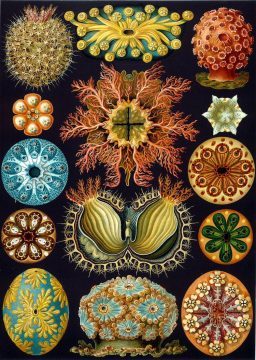Emma Taggart in My Modern Met:
 Today, many science books are full of detailed photos that reveal the intricate parts of plant life, but prior to the invention of photography (and macro photography), it was up to botanical illustrators and researchers to record the fascinating forms of flora and fauna. One scientist who recorded his findings with drawings is Ernst Heinrich Haeckel, a German biologist, naturalist, philosopher, and physician.
Today, many science books are full of detailed photos that reveal the intricate parts of plant life, but prior to the invention of photography (and macro photography), it was up to botanical illustrators and researchers to record the fascinating forms of flora and fauna. One scientist who recorded his findings with drawings is Ernst Heinrich Haeckel, a German biologist, naturalist, philosopher, and physician.
Made during the late 19th and early 20th centuries, his brilliantly colorful and highly stylized drawings, watercolors, and sketches reveal how different forms of plant life appear under the microscope. Although each hand-drawn organism looks like something from a science fiction book, Haeckel’s body of work sheds light on the incredible hidden intricacies of real, natural forms that inhabit the Earth.
Born in Germany in 1834, Ernst Haeckel studied medicine at the University of Berlin and graduated in 1857. While he was a student, his professor Johannes Müller, took him on a summer field trip to observe small sea creatures off the coast of Heligoland in the North Sea, sparking his life-long fascination for natural forms and biology. In 1859, when Haeckel was 25, he traveled to Italy where he spent time in Napoli discovering his artistic talent. In the same year, he went to Messina where he studied the structures of radiolarians (microscopic protozoa that produce intricate mineral skeletons). He published 59 scientific illustrations between 1860 and 1862, along with the original microscope slides.
More here. (Note: Thanks to dear friend Bim Bissel)
